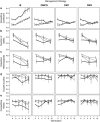An experimental evaluation with Drosophila melanogaster of a novel dynamic system for the management of subdivided populations in conservation programs
- PMID: 20823908
- PMCID: PMC3186228
- DOI: 10.1038/hdy.2010.117
An experimental evaluation with Drosophila melanogaster of a novel dynamic system for the management of subdivided populations in conservation programs
Abstract
A dynamic method (DM) recently proposed for the management of captive subdivided populations was evaluated using the pilot species Drosophila melanogaster. By accounting for the particular genetic population structure, the DM determines the optimal mating pairs, their contributions to progeny and the migration pattern that minimize the overall co-ancestry in the population with a control of inbreeding levels. After a pre-management period such that one of the four subpopulations had higher inbreeding and differentiation than the others, three management methods were compared for 10 generations over three replicates: (1) isolated subpopulations (IS), (2) one-migrant-per-generation rule (OMPG), (3) DM aimed to produce the same or lower inbreeding coefficient than OMPG. The DM produced the lowest co-ancestry and equal or lower inbreeding than the OMPG method throughout the experiment. The initially lower fitness and lower variation for nine microsatellite loci of the highly inbred subpopulation were restored more quickly with the DM than with the OMPG method. We provide, therefore, an empirical illustration of the usefulness of the DM as a conservation protocol for captive subdivided populations when pedigree information is available (or can be deduced) and manipulation of breeding pairs is possible.
Figures




References
-
- Allendorf FW, Luikart G. Conservation and the Genetics of Populations. Blackwell Publishing: Malden, MA, USA; 2007.
-
- Bachtrog D, Agis M, Imhof M, Schlötterer C. Microsatellite variability differs between dinucleotide repeat motifs—evidence from Drosophila melanogaster. Mol Biol Evol. 2000;17:1277–1285. - PubMed
-
- Ballou J, Lacy R.1995Identifying genetically important individuals for management of genetic variation in pedigreed populationsIn: Ballou JD, Gilpin M, Foose TJ (eds).Population Management for Survival and Recovery Columbia University Press: New York; 76–111.
-
- Branch LC, Clark AM, Moler PE, Bowen BW. Fragmented landscapes, habitat specificity, and conservation genetics of three lizards in Florida scrub. Conserv Genet. 2003;4:199–212.
-
- Caballero A, Santiago E, Toro MA. Systems of mating to reduce inbreeding in selected populations. Anim Sci. 1996;62:431–442.
Publication types
MeSH terms
LinkOut - more resources
Full Text Sources
Molecular Biology Databases

